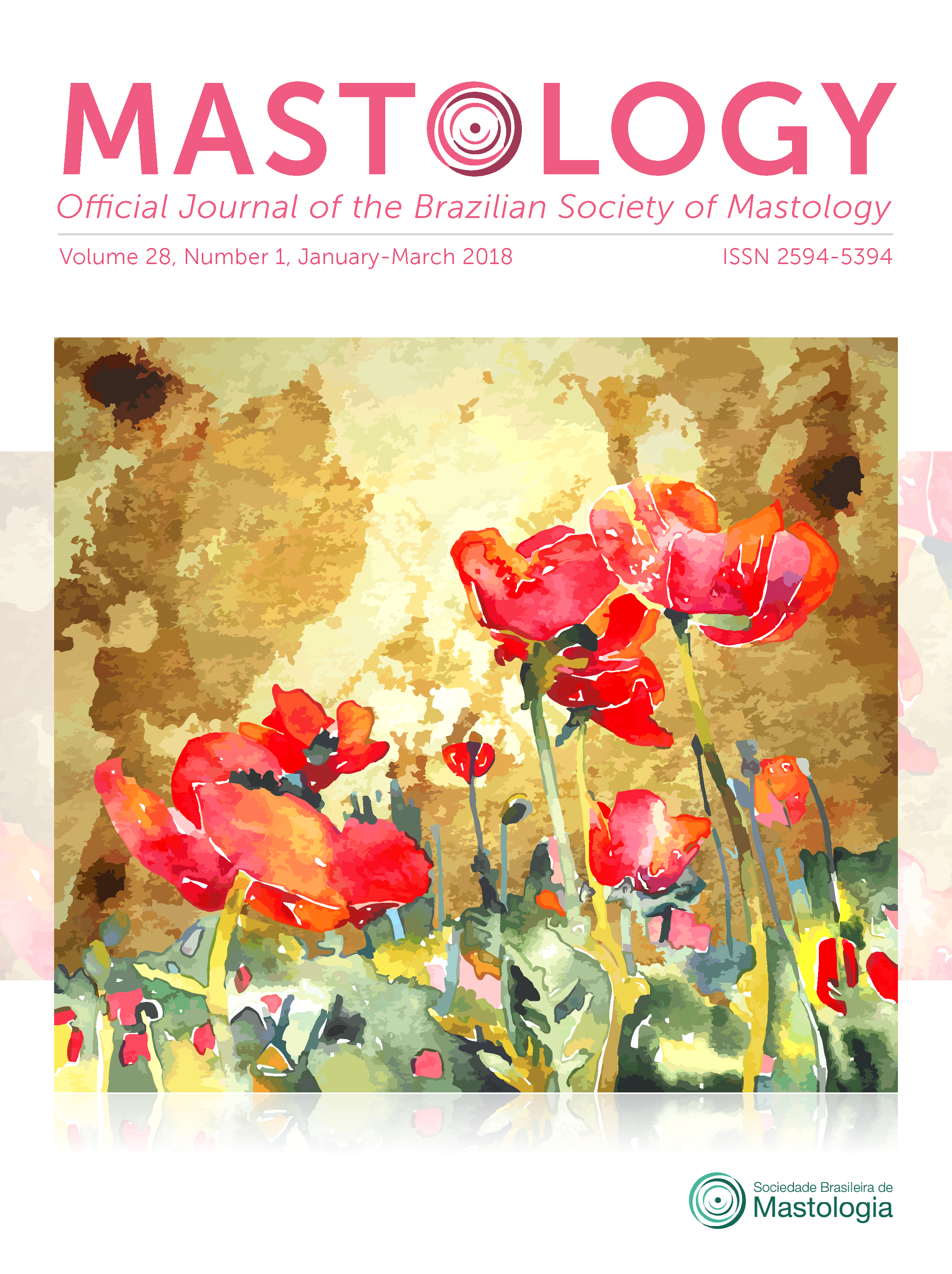INTRAPAPILLARY DUCT DILATION
A NEW ULTRASONOGRAPHY SIGN
Keywords:
breast ultra-sonography, nipple discharge, mammary duct ectasia, papilloma, breast neoplasmsAbstract
Objective: To evaluate a not yet described ultrasound finding, the dilation of the intra-papillary portion of the lactiferous duct in patients with or without abnormal nipple discharge Methods: 24 patients with pathological nipple discharge and intrapapillary duct dilation and 1,255 asymptomatic patients (control group) were studied. Results: Just one asymptomatic patient had intrapapillary duct dilation. Among the symptomatic patients, 19 were biopsied: ten with exclusively percutaneous approach, six with exclusively surgical approach, and three with an initial percutaneous and then a surgical approach. There was one invasive carcinoma and two carcinomas in situ (15.8% of the biopsied patients). In 11 patients, a papilloma was found, three of them with atypia. In one patient, ultrasonography identified intrapapillary extension of microcalcifications, and another patient a changed duct diametrically opposite to the duct which had a trigger point. In these two patients, the examination changed the treatment strategy. In two other patients, an extra-papillary finding was identified only after the intrapapillary duct dilation has been encountered. Conclusion: The intrapapillary duct dilation is a new ultrasonography sign that adds sensitivity to the evaluation of the patient with pathological nipple discharge, besides helping to find the lesion and to guide the treatment. Further research is needed to determine its prevalence and its positive and negative predictive values for cancer, atypia and papilloma.
Downloads
References
Richards T, Hunt A, Courtney S, Umeh H. Nipple discharge: a sign of breast cancer? Ann R Coll Surg Engl. 2007;89:124-6.https://doi.org/10.1308/003588407X155491
van Gelder L, Bisschops RH, Menke-Pluymers MB, Westenend PJ, Plaisier PW. Magnetic resonance imaging in patients with unilateral bloody nipple discharge; useful when conventional diagnostics are negative? World J Surg. 2015;39(1):184-6. https://doi.org/10.1007/s00268-014-2701-1
Fisher CS, Margenthaler JA. A look into the ductoscope: its role in pathologic nipple discharge. Ann Surg Oncol. 2011;18(11):3187-91. https://doi.org/10.1245/s10434-011-1962-2
Gupta RK, Gaskell D, Dowle CS, Simpson JS, King BR, Naran S, et al. The role of nipple discharge cytology in the diagnosis of breast disease: a study of 1948 nipple discharge smears from 1530 patients. Cytopathology. 2004;15:326-30. https://doi.org/10.1111/j.1365-2303.2004.00169.x
Hou MF, Tsai KB, Ou-Yang F, Lin HJ, Liu CS, Chai CY, et al. Is a one-step operation for breast cancer patients presenting nipple discharge without palpable mass feasible? Breast. 2002;11:402-7. https://doi.org/10.1054/brst.2002.0441
Nazario ACP, Rego MF, Oliveira VM. Nódulos benignos da mama: uma revisão dos diagnósticos diferenciais e conduta. Rev Bras Ginecol Obstet. 2007;29(4):211-9. http://dx.doi.org/10.1590/S0100-72032007000400008
Mokbel K, Escobar PF, Matsunaga T. Mammary ductoscopy: current status and future prospects. Eur J Surg Oncol. 2005;31:3-8. https://doi.org/10.1016/j.ejso.2004.10.004
Bahl M, Gadd MA, Lehman C. Diagnostic Utility of MRI After Negative or Inconclusive Mammography for the Evaluation of Pathologic Nipple Discharge. AJR Am J Roentgenol. 2017;209:1404-10. https://doi.org/10.2214/AJR.17.18139
Seow JH, Metcalf C, Wylie E. Nipple discharge in a screening programme: imaging findings with pathological correlation. J Med Imaging Radiat Oncol. 2011;55(6):577-86. https://doi.org/10.1111/j.1754-9485.2011.02294.x
Torres-Tabanera M, Alonso-Bartolomé P, Vega-Bolivar A, Sánchez-Gómez SM, Lag-Asturiano E, Sainz-Miranda M, et al. Percutaneous microductectomy with a directional vacuum-assisted system guided by ultrasonography for the treatment of breast discharge: experience in 63 cases. Acta Radiol. 2008;49(3):271-6. https://doi.org/10.1080/02841850701769793
Stavros AT. Breast anatomy: the basis for understanding sonography. In: Stavros AT. Breast ultrasound. Philadelphia: Lippincott Williams & Wilkins; 2004.p.85-9.
Da Costa D, Taddese A, Cure ML, Gerson D, Poppiti R, Esserman LE. Common and Unusual Diseases of the Nipple Areolar Complex. RadioGraphics. 2007;27:S65-77. https://doi.org/10.1148/rg.27si075512
Eiada R, Chong J, Kulkarni S, Goldberg F, Muradali D. Papillary Lesions of the Breast: MRI, Ultrasound, and Mammographic Appearances. AJR Am J Roentgenol. 2012;198:264-71. https://doi.org/10.2214/AJR.11.7922
Downloads
Published
How to Cite
Issue
Section
License
Copyright (c) 2018 Hélio Sebastião Amâncio de Camargo Júnior, Sandra Regina Campos Teixeira, Marcia Martos Amâncio de Camargo, Marcia Martos Amâncio de Camargo, Juliana Azevedo, Maurício de Souza Arruda

This work is licensed under a Creative Commons Attribution 4.0 International License.







